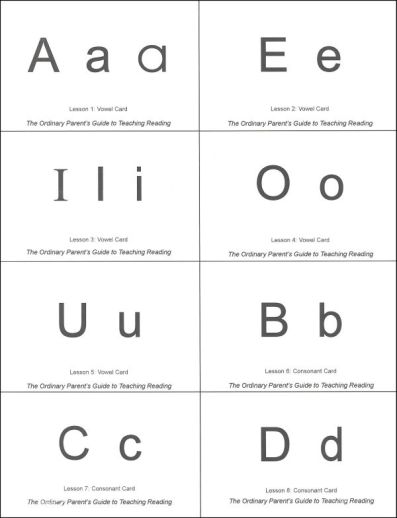We use cookies to make your experience better. To comply with the new e-Privacy directive, we need to ask for your consent to set the cookies. Learn more.
Ordinary Parent's Guide to Teaching Reading Flashcards
This set of 320 pre-printed cardstock Flashcards correlate with the lessons in the Ordinary Parent's Guide.
Programs in this section focus primarily on teaching children to read, and may not provide comprehensive instruction in reading comprehension, spelling, writing, or other language skills. Arranged roughly by grade.
Recently revised with updated content and formatting, the Ordinary Parent's Guide to Teaching Reading takes everything we loved about the original edition and makes it even better! Building on the premise that there are no extraordinary or "professional" skills needed to teach a child to read, parents will find the confidence here to teach their children successfully.
While the lessons are nearly the same with updated words and stories, there is more teaching support and the format has changed from one large parent/student manual to two required books – The Instructor Book and Student Book.
The Instructor Guide begins with a How to Use section, followed by the phonics lessons. If you are new to teaching phonics or unfamiliar with phonics as a reading method (like this writer who learned to read through Dick and Jane and the look-say method), you may want to read Part 2 first. Here, the "ordinary" parent finds sections on preparing a young child to be a reader, managing the reading session, encouraging a child to be a reader, working with remedial readers, a key to phonetic symbols as well as a collection of questions and answers. The phonics instruction starts with short-vowel sounds; then it progresses through consonant sounds; short-vowel words; two-consonant blends; consonant digraphs; three-consonant beginning blends; long-vowel sounds; silent-e words; long-vowel sound spellings; other vowel sound spellings; other spellings for short-vowel sounds; silent letters; r-changed vowels; two-syllable words; other letter patterns and silent letters; possessive words and contractions; other spellings for the long-e sound; plural and hyphenated words; three-syllable words; endings, suffixes, and prefixes; more letter patterns; and a final section on homonyms, homophones, and homographs. Following a typical pattern, lessons are scripted with necessary supplies clearly noted. Intermingled with the instructor's words are explanations of phonics specifics [i.e. ng looks like a consonant blend (two distinct sounds blended together), but it is actually a consonant digraph (two letters representing a single speech sound)]. These explanations are extremely helpful for the "ordinary" parent who wishes to understand phonics terminology. Many lessons include optional follow-up activities to review the lesson or previously learned material. All of the Student materials previously found in the Ordinary Parents Guide to Teaching Reading Manual are now found in the separate Student Book.
The Student Book provides all the student readings – sometimes individual words, sometimes sentences, sometimes rhymes, sometimes little stories – all in large print. There is a cleverness permeating the reading material; a tendency toward alliteration and rhyme resulting in what might be classified as tongue twisters. Starting with the lessons on two-consonant blends, the author introduces the "Two Review and One New" teaching technique. This is a combination of noting lessons where total mastery was not quite achieved and reviewing those lessons along with the most recently covered lesson ("review two"), and introducing the new lesson. While not present in every lesson, reinforcement activities are interspersed among the instruction such as the "eat a treat" game or use of a magnetic alphabet board. Occasionally additional supplies like the magnetic alphabet board are needed for optional activities, but usually blank index or printed cards and a pen are the only supplies needed. If you want to save yourself the prep time, however, a set of 320 pre-printed cardstock flashcards are available which correlate with the lessons in the book. The Audio Companion CD is another optional but helpful resource which features correct pronunciation of the phonetic sounds learned in the program through rhymes and songs.
Readers of the Well-Trained Mind will not be surprised to learn the author believes reading instruction can typically be started with a four- or five-year-old and sometimes with a three-year-old. For these young ones, introductory lessons can be short – ten minutes, and gradually progress to a more common timeframe of thirty minutes. Effective phonics/reading instruction requires the teacher to be continually patient, and for teaching sessions to be frequent and consistent (i.e. daily). She similarly maintains that reading, writing, and spelling instruction should be sequential rather than simultaneous.
In summary, with this program the "ordinary" parent is given an extremely usable and comprehensive tool not only for teaching reading, but also for learning and understanding the dynamics of phonics instruction and for reinforcing the importance of a disciplined learning environment. Instructor Guide is 559 pages. The Student Book is 335 pages. Reproducible for original purchaser's family only. ~ Janice/Deanne
| Product Format: | Other |
|---|---|
| Brand: | Well-Trained Mind Press |
| Grade: | AD |
| Length in Inches: | 11 |
| Width in Inches: | 8.5 |
| Height in Inches: | 0.25 |
| Weight in Pounds: | 0.9 |

